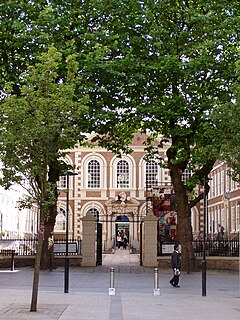Bluecoat Chambers
| The Bluecoat | |
|---|---|
 |
|
|
Location within Liverpool
|
|
| Former names | Bluecoat School, Bluecoat Chambers, Bluecoat Arts Centre |
| General information | |
| Architectural style | Queen Anne |
| Location | School Lane, Liverpool, Merseyside, England |
| Coordinates | 53°24′15″N 2°59′02″W / 53.4042°N 2.9839°W |
| Construction started | 1716 |
| Completed | 2008 |
| Client | Bryan Blundell |
Built in 1716-17 as a charity school, Bluecoat Chambers in School Lane is the oldest surviving building in central Liverpool, England. Following the Liverpool Blue Coat School's move to another site in 1906, the building was rented from 1907 onwards by the Sandon Studios Society. Based on the presence of this art society and the subsequent formation of the Bluecoat Society of Arts in 1927, the successor organisation laid claim to being the oldest arts centre in Great Britain, now called The Bluecoat.
The school was founded in 1708 or 1709 by the Reverend Robert Styth (died in 1713), rector of Liverpool, and Bryan Blundell, a sea captain and later twice Mayor of Liverpool (1721–22 and 1728–29). Originally constructed in 1716-17, the building was extended until 1718 to function as a boarding school. By the following year it had 50 children, with room for 100 more, and construction was finally completed in 1725.
After the school moved to a new site in Wavertree in 1906, the building was threatened with demolition. It was rented out from 1907 to the Sandon Studios Society, an independent art school and art society. The building's future still unsecured, it took the intervention of the architect Charles Herbert Reilly, head of the Liverpool School of Architecture. He convinced the industrialist William Lever to rent Bluecoat Chambers in 1909 and subsequently buy it, renaming it Liberty Buildings. Sharing the space with the Sandon Society, Reilly moved in with his School of Architecture from 1909 until shortly after World War I. In 1913-14, Lever entertained the thought of a larger building scheme to transform Liberty Buildings into an art centre but, by 1918, got tired with the idea. Lever's death in 1925 again led to proposals for demolition. A successful campaign to raise money for the purchase of Bluecoat Chambers resulted in the establishment of the Bluecoat Society of Arts in 1927 as a charitable trust to run the building.
On 3 May 1941, during the Liverpool Blitz, the concert hall and adjoining rooms were severely damaged by an incendiary bomb and during the following night the rear wing was destroyed by a bomb blast. Restoration took place after the war, being completed by 1951. It is recorded in the National Heritage List for England as a designated Grade I listed building, having been designated on 28 June 1952.
...
Wikipedia

